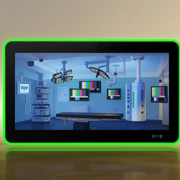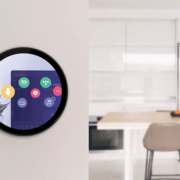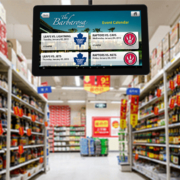What Should We Consider to Purchase the Digital Signage?
What Should We Consider to Purchase the Digital Signage?
Digital signage has become an essential part of modern business, revolutionizing how brands communicate with customers, enhance user experiences, and promote products. Whether you are setting up a POS system, in-store displays, or public information kiosks, choosing the right digital signage solution is critical to ensuring the success of your project. With so many options available, it’s important to consider several factors to ensure the system you purchase meets your business needs and goals.
In this article, we’ll walk you through the key considerations when purchasing digital signage for your business.
1. Display Size & Resolution
The size and resolution of the digital signage display are among the most important factors to consider. The ideal size depends on where and how you intend to use the screen.
- Display Size: Larger screens are better for attracting attention in high-traffic areas such as retail stores, shopping malls, or airports, while smaller screens are ideal for more intimate spaces, like reception areas or POS terminals. For example, if you want to place the screen on a wall, 15.6-inch to 32-inch displays are popular choices for POS digital signage, whereas 55-inch or larger displays are more suitable for public areas.
- Resolution: Higher resolution ensures that your content looks crisp and professional. For most indoor retail environments, 1080p (Full HD) resolution is sufficient. However, for larger displays or outdoor environments, you may want to consider 4K resolution for a more detailed image. The YC-L156 Glow-Frame Tablet provides full HD (1920×1080) resolution, making it ideal for high-quality content in interactive POS systems or digital signage.
2. Type of Display (Interactive vs. Non-Interactive)
Decide whether you want interactive or non-interactive digital signage. This decision largely depends on the type of experience you want to provide to your customers.
- Non-Interactive Displays: Ideal for showcasing static or dynamic content such as advertisements, product information, or promotions. These displays are commonly used in public spaces and retail environments to inform or attract customers. If your focus is on one-way communication, a non-interactive screen will be sufficient.
- Interactive Displays: These allow customers to engage directly with the content, making them ideal for POS terminals, wayfinding systems, or self-service kiosks. Interactive screens, like the YC-L156, enable customers to browse products, view promotions, and even make purchases or check out, providing a more immersive and engaging experience.
3. Content Management System (CMS)
A Content Management System (CMS) is essential for controlling and scheduling the content displayed on your digital signage. Some screens come with built-in CMS, while others require external software.
- Ease of Use: Look for a CMS that is user-friendly and easy to update, even if you’re not particularly tech-savvy. You should be able to upload images, videos, and real-time updates with minimal effort.
- Cloud vs. On-Premise: Some businesses may prefer cloud-based CMS to manage content remotely, while others may require an on-premise CMS for more security or control. The cloud-based CMS allows for remote updates and is ideal for managing multiple screens across different locations. With Portworld’s digital signage solutions, businesses can benefit from flexible CMS options, enabling centralized management across various devices.
4. Connectivity Options
Connectivity is crucial for ensuring that your digital signage remains functional and can be updated easily. When choosing digital signage, make sure it supports the necessary connectivity options:
- Wi-Fi or Ethernet: For easy content updates and management, Wi-Fi connectivity is a great option. Ethernet is better for more secure and stable connections, especially in areas with lots of network traffic.
- USB Ports and HDMI: USB ports are essential for plugging in external devices, while HDMI ports are necessary for video inputs or connecting to a secondary display.
- Bluetooth: For systems like POS terminals, Bluetooth functionality may be required for seamless integration with payment processing devices, printers, and scanners.
5. Durability & Operating Environment
Consider the environment in which your digital signage will be used. The durability and design of the screen will determine its lifespan and ability to perform in various conditions.
- Indoor vs. Outdoor Use: If your digital signage is going to be installed outdoors, look for displays designed for outdoor use, which are typically more weather-resistant, have higher brightness levels, and can withstand varying temperatures.
- Temperature & Humidity Resistance: For industrial settings or areas with extreme environmental conditions, make sure the signage is built to withstand these factors.
- Screen Protection: If the digital signage is going to be in high-traffic areas or exposed to frequent use, it’s advisable to choose screens with anti-glare protection, tempered glass, or scratch-resistant surfaces.
6. Power Options (PoE, Energy Efficiency)
Digital signage systems often require consistent power, which makes power efficiency and options important.
- Power over Ethernet (PoE): Some devices, like the YC-L156, support PoE (Power over Ethernet), which allows both data and power to be transmitted through a single Ethernet cable. This simplifies installation and reduces the need for extra power outlets, making it ideal for large-scale installations.
- Energy Efficiency: Look for digital signage solutions with low power consumption to reduce operational costs, especially if you plan to run them 24/7.
7. Cost vs. Long-Term Value
The upfront cost of digital signage is important, but you should also consider the long-term value it brings.
- Initial Investment: Basic non-interactive digital signage displays may cost less, while interactive displays, larger screens, or systems with advanced features may require a higher initial investment.
- Ongoing Costs: Factor in any subscription fees for content management systems, regular maintenance, energy consumption, and possible upgrade costs.
- ROI (Return on Investment): Digital signage can boost sales, improve customer engagement, and enhance the shopping experience, making it a valuable long-term investment. Systems with high reliability and easy content management can help ensure you get the most value over time.
8. Scalability and Future-Proofing
Consider how your digital signage needs might evolve. Will your solution be scalable if you decide to expand or add more displays in the future?
- Scalability: Some digital signage systems allow for easy expansion to multiple screens or integration with other systems like POS or smart home controls.
- Future-Proofing: Choose a system that can be easily updated to support new features or technologies, ensuring your investment remains relevant for years to come.
Purchasing digital signage is a significant decision that can have a huge impact on customer engagement, sales, and overall brand experience. To ensure you select the right digital signage for your business, consider factors like display size, resolution, connectivity options, content management, and durability. By choosing a solution that fits your needs today and can scale for the future, you can optimize your investment and maximize its impact.










